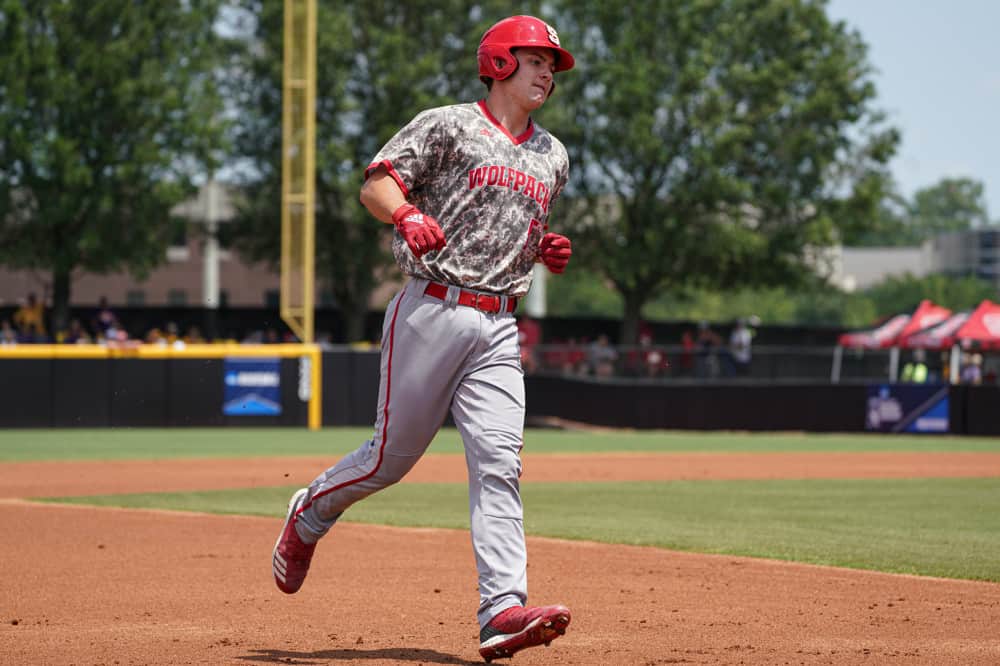In light of Jim Callis, Keith Law and the Baseball America staff mocking NC State catcher Patrick Bailey to the Chicago White Sox at Pick 11, he kicks off our 2020 MLB Draft Player Profiles.
Background
Following in the footsteps of Joey Bart and Adley Rutschman, Patrick Bailey is this year's highest-ranked college catcher. At one point last year, there was chatter that Bailey could be drafted in the Top 5 like Bart and Rutschman because of his defensive skills and ability to hit from both sides of the plate.
That draft stock cooled off a bit as Bailey hit .231/.333/.308 in nine games with Team USA last summer, due in large part to his 12 strikeouts in just 26 at-bats. Small sample size, but that strikeout tendency carried over to the 17 games he played in 2020, which Bailey punched out 18 times in just 73 plate appearances (24.7 K%).
Outside of the swing and miss, Bailey is a switch-hitting catcher who demonstrates average power (50 grade) from both sides. In 131 games at NC State, Bailey hit .302/.411/.568 with 29 home runs and 106 RBI. He was the ACC Freshman of the Year in 2018, and All-ACC First Team in 2019.
Bailey stands 6'2" and will turn 21 years old on May 29. The Minnesota Twins drafted Bailey in the 37th round back in 2018.
Hitting
It was just four years ago that the White Sox spent their 10th overall pick on catcher Zack Collins, whose scouting report was much different than Bailey's. Collins was an offensive-first catcher, and scouts had serious concerns about his ability to stay behind the plate. Bailey is a switch-hitting catcher whose strongest trait is his defense. Comparing what they achieved in college:
| Metric | Zack Collins | Patrick Bailey |
| K% | 19.6 | 18.6 |
| BB% | 21.1 | 17.2 |
| BABIP | .366 | .318 |
| ISO | .282 | .266 |
| XBH% | 43.3 | 43.8 |
Collins had the better slash line (.319/.472/.607) and played 68 more games than Bailey did in college. Since Collins has been in the White Sox system:
| Metric | 2017 (A+/AA) | 2018 (AA) | 2019 (AAA) |
| K% | 27.7/24.4 | 29.8 | 26.7 |
| BB% | 17.8/24.4 | 19.0 | 16.9 |
| BABIP | .282/.286 | .329 | .346 |
| ISO | .220/.235 | .170 | .265 |
| XBH% | 50.0/50.0 | 40.8 | 46.9 |
The swing and miss in Collins game carried over from college, but he still maintained a good walk rate while demonstrating power when he made contact. The concern for Collins moving forward is whether he can tap into that power against better command in the majors. His first taste suggests Collins needs some more progress, and that's part is the reason why the White Sox signed Yasmani Grandal this offseason.
I could see Bailey following a similar path offensively to Collins. Personally, I think he’s better swinging left-handed. The stance is open and he does a good job of using his lower half to generate loft when making contact. His right-handed stance is more closed with a gap-to-gap approach.
Defense
What gets scouts and analysts hyped about Bailey is his defense, and this is where comparisons to Collins or Yermín Mercedes wouldn't be worthwhile if the White Sox selected him. To start, Bailey calls his own games. That’s very uncommon to see in the college game. It speaks to Bailey’s game preparation and his ability to handle a pitching staff. To boot, in 2019, NC State’s pitching staff led the conference in ERA.
Even at 6’2”, Bailey moves well behind the plate. Typically when watching college catchers, you can tell if they prefer moving one side to another. For example, pitches that are in the dirt moving to the left are better blocked than moving to their right. I don’t see Bailey favoring one side over the other. He seems to be well-balanced, which is something we can’t say watching Mercedes try to catch. In his freshman season, Bailey allowed 13 passed balls. The next two seasons? Two and two. That’s very impressive for a college catcher.
Then there's Bailey's throwing arm. Speaking to a few analysts who saw Bailey at Team USA this past summer, they had him clocked at 1.9 pop time, which is 50-grade. In highlights, Bailey is throwing from multiple angles and they are not consistent. However, they find their way to second base on target. In 2019, Bailey threw out 32.5% of basestealers but was only 1-for-14 in 2020. This part of Bailey’s defense could use some more work getting into a better throwing stance.
Summary
Selecting Patrick Bailey 11th overall would follow the White Sox trend adding “safe” college players with higher floors but with a lower ceiling. Best case scenario might be that Bailey turns out to be a better defensive version of Matt Wieters. Worst case is that Bailey is a backup catcher because the strikeouts pile up and he doesn’t show enough power at the plate.
(Photo by Greg Thompson/Icon Sportswire)





